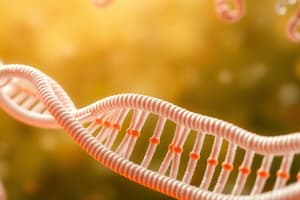Podcast
Questions and Answers
What is the role of ribozymes in cellular processes?
What is the role of ribozymes in cellular processes?
- Ribozymes are involved in the replication of DNA.
- Ribozymes have catalytic roles in processes such as RNA cutting, molecule replication, and protein bond formation. (correct)
- Ribozymes are responsible for the transcription of DNA into RNA.
- Ribosomes catalyze the formation of peptide bonds between amino acids in protein synthesis.
What percentage of the eukaryotic genome is made up of genes?
What percentage of the eukaryotic genome is made up of genes?
- 1-1.5% (correct)
- 50-60%
- 10-15%
- 90-95%
What is the main difference between DNA and RNA?
What is the main difference between DNA and RNA?
- DNA is single-stranded, while RNA is double-stranded.
- DNA contains the sugar deoxyribose, while RNA contains the sugar ribose. (correct)
- DNA is found in the cytoplasm, while RNA is found in the nucleus.
- DNA is involved in protein synthesis, while RNA is involved in DNA replication.
What is the process of transcription?
What is the process of transcription?
What are enhancers and silencers in the context of gene expression?
What are enhancers and silencers in the context of gene expression?
What is the function of RNA polymerase in the process of gene expression?
What is the function of RNA polymerase in the process of gene expression?
What is the term for the process where a single gene can produce multiple proteins?
What is the term for the process where a single gene can produce multiple proteins?
What is the role of promoters in gene expression?
What is the role of promoters in gene expression?
What is the primary location for the transcription of genes to RNA in eukaryotic cells?
What is the primary location for the transcription of genes to RNA in eukaryotic cells?
What does gene expression primarily refer to?
What does gene expression primarily refer to?
Which of the following statements about gene-to-protein relationships is correct?
Which of the following statements about gene-to-protein relationships is correct?
Which class of RNA is not involved in protein synthesis?
Which class of RNA is not involved in protein synthesis?
What was the initial model proposed regarding gene function?
What was the initial model proposed regarding gene function?
Which scientist is associated with the discovery of the molecular basis of phenotypes?
Which scientist is associated with the discovery of the molecular basis of phenotypes?
In eukaryotic gene expression, what is the significance of the process being compartmentalized?
In eukaryotic gene expression, what is the significance of the process being compartmentalized?
What genetic condition is characterized by an inability to produce melanin?
What genetic condition is characterized by an inability to produce melanin?
What is the significance of the CCAAT box in RNA polymerase II promoters?
What is the significance of the CCAAT box in RNA polymerase II promoters?
When does abortive initiation of transcription occur?
When does abortive initiation of transcription occur?
What happens to RNA polymerase II after it synthesizes a transcript of approximately 30 nucleotides?
What happens to RNA polymerase II after it synthesizes a transcript of approximately 30 nucleotides?
What characterizes the open complex in transcription?
What characterizes the open complex in transcription?
How do transcription factors interact with RNA polymerase II during transcription?
How do transcription factors interact with RNA polymerase II during transcription?
What is the role of RNA polymerase during transcription?
What is the role of RNA polymerase during transcription?
Which strand of DNA serves as the template during transcription?
Which strand of DNA serves as the template during transcription?
In which direction does transcription occur?
In which direction does transcription occur?
What are the three main stages of transcription?
What are the three main stages of transcription?
What is found at the beginning of a transcription unit?
What is found at the beginning of a transcription unit?
What requirement must be fulfilled before transcription can initiate?
What requirement must be fulfilled before transcription can initiate?
If the DNA strand used as a template is 5’–GTACCGTC–3’, what is the correct sequence of the transcribed RNA?
If the DNA strand used as a template is 5’–GTACCGTC–3’, what is the correct sequence of the transcribed RNA?
What is the significance of the +1 nucleotide in a transcription unit?
What is the significance of the +1 nucleotide in a transcription unit?
What is the primary role of the mediator complex in transcription regulation?
What is the primary role of the mediator complex in transcription regulation?
Which RNA polymerase is responsible for transcribing protein-coding genes in eukaryotes?
Which RNA polymerase is responsible for transcribing protein-coding genes in eukaryotes?
What is a gene primarily defined as?
What is a gene primarily defined as?
What is the significance of the TATA box in the core promoter?
What is the significance of the TATA box in the core promoter?
Which of the following correctly describes the interaction between transcription factors and enhancers?
Which of the following correctly describes the interaction between transcription factors and enhancers?
What role do introns play in gene expression?
What role do introns play in gene expression?
Where is the promoter region typically located?
Where is the promoter region typically located?
Which statement about the structure of transcription machinery is true?
Which statement about the structure of transcription machinery is true?
Which of the following statements about regulatory regions is true?
Which of the following statements about regulatory regions is true?
What role do regulatory proteins play in transcription?
What role do regulatory proteins play in transcription?
What is the purpose of splicing in the processing of RNA?
What is the purpose of splicing in the processing of RNA?
How does RNA polymerase II differ from other RNA polymerases in eukaryotes?
How does RNA polymerase II differ from other RNA polymerases in eukaryotes?
What is required for eukaryotic RNA polymerase to recognize DNA sequences?
What is required for eukaryotic RNA polymerase to recognize DNA sequences?
What is the termination region's role in a gene?
What is the termination region's role in a gene?
What is the longest human gene known to code for dystrophin?
What is the longest human gene known to code for dystrophin?
Which nucleotide sequences decrease gene expression?
Which nucleotide sequences decrease gene expression?
Flashcards
Eukaryotic Genes
Eukaryotic Genes
Structures made of DNA that code for RNA and proteins in eukaryotes.
RNA Classes
RNA Classes
Various types of RNA, each with distinct functions in the cell.
RNA Polymerase
RNA Polymerase
Enzyme that synthesizes RNA from a DNA template during transcription.
Eukaryotic Transcription
Eukaryotic Transcription
Signup and view all the flashcards
Promoters and Enhancers
Promoters and Enhancers
Signup and view all the flashcards
RNA Processing
RNA Processing
Signup and view all the flashcards
Alternative Splicing
Alternative Splicing
Signup and view all the flashcards
Intergenic Regions
Intergenic Regions
Signup and view all the flashcards
Gene
Gene
Signup and view all the flashcards
Eukaryotic gene structure
Eukaryotic gene structure
Signup and view all the flashcards
Regulatory regions
Regulatory regions
Signup and view all the flashcards
Promoter
Promoter
Signup and view all the flashcards
Termination region
Termination region
Signup and view all the flashcards
Introns
Introns
Signup and view all the flashcards
Exons
Exons
Signup and view all the flashcards
Splicing
Splicing
Signup and view all the flashcards
Gene Expression
Gene Expression
Signup and view all the flashcards
Transcription
Transcription
Signup and view all the flashcards
mRNA
mRNA
Signup and view all the flashcards
One Gene - One Enzyme
One Gene - One Enzyme
Signup and view all the flashcards
Polypeptide
Polypeptide
Signup and view all the flashcards
Structural RNA Genes
Structural RNA Genes
Signup and view all the flashcards
Albinism
Albinism
Signup and view all the flashcards
George Beadle & Edward Tatum
George Beadle & Edward Tatum
Signup and view all the flashcards
RNA Classes in Protein Synthesis
RNA Classes in Protein Synthesis
Signup and view all the flashcards
Transcription Unit
Transcription Unit
Signup and view all the flashcards
Template Strand
Template Strand
Signup and view all the flashcards
Transcription Direction
Transcription Direction
Signup and view all the flashcards
RNA Polymerase Function
RNA Polymerase Function
Signup and view all the flashcards
Transcription Stages
Transcription Stages
Signup and view all the flashcards
Initiation of Transcription
Initiation of Transcription
Signup and view all the flashcards
Termination of Transcription
Termination of Transcription
Signup and view all the flashcards
CCAAT box
CCAAT box
Signup and view all the flashcards
Open complex
Open complex
Signup and view all the flashcards
Abortive initiation
Abortive initiation
Signup and view all the flashcards
Elongation
Elongation
Signup and view all the flashcards
RNA polymerase II
RNA polymerase II
Signup and view all the flashcards
Accessory Proteins
Accessory Proteins
Signup and view all the flashcards
Basal Apparatus
Basal Apparatus
Signup and view all the flashcards
RNA Polymerases in Eukaryotes
RNA Polymerases in Eukaryotes
Signup and view all the flashcards
TATA Box
TATA Box
Signup and view all the flashcards
Transcription Factors (TFs)
Transcription Factors (TFs)
Signup and view all the flashcards
Regulatory Promoter
Regulatory Promoter
Signup and view all the flashcards
Mediator Complex
Mediator Complex
Signup and view all the flashcards
Chromatin Structure
Chromatin Structure
Signup and view all the flashcards
Study Notes
Gene Expression: From DNA to RNA
- Eukaryotic genes are organized into coding and regulatory regions
- Genes control traits – transcribed into RNA, then translated into proteins
- Only a small portion of the genome (1-1.5%) consists of genes
- The set of expressed genes in a cell determines its function
Eukaryotic Gene Structure
- Genes have regulatory and coding regions
- Regulatory regions (e.g., promoter) control gene expression
- Promoters are DNA sequences where proteins bind for transcription initiation.
- Termination regions mark transcription's end.
- Introns are non-coding sections of RNA transcripts that are removed, while exons code for functional products.
- Splicing is the intron removal process.
- The largest human gene (DMD) codes for dystrophin (79 exons, 2300 kb).
RNA Classes and Functions
- Three main RNA classes are involved in protein synthesis: mRNA, rRNA, tRNA
- mRNA carries genetic information from DNA to ribosomes for protein synthesis.
- rRNA forms the ribosomal structure and facilitates translation.
- tRNA brings amino acids to the ribosome to build the protein.
Transcription Stages
- Transcription copies DNA information into RNA
- Stages include Initiation, Elongation, and Termination
- Initiation involves the transcription machinery binding to the promoter for synthesis.
- Elongation involves RNA polymerase moving along the template and adding nucleotides.
- Termination involves RNA polymerase detaching and releasing RNA.
RNA Polymerases
- Eukaryotes have three main RNA polymerases (I, II, III)
- Different polymerases transcribe different genes (e.g., RNA polymerase II transcribes protein-coding genes).
Transcription Regulation
- Initiation involves many accessory proteins to bind to and recruit polymerase
- Transcription factors (TFs) bind to specific DNA sequences.
- Enhancers and silencers alter transcription rate—can be far from the transcribed gene.
- Core promoters contain essential sequences (like TATA box) to help RNA polymerase bind.
- Regulatory promoters influence transcription speed via mediators.
- The basal transcription apparatus consists of RNA pol II plus other proteins.
- DNA and RNA polymerase II change shapes to expose the template and unwind DNA.
The Transcription Unit
- Composed of promoter, RNA coding sequence, and terminator.
- The first transcribed nucleotide is +1.
Abortive Initiation
- RNA polymerase is stalled and releases the short strands of RNA.
- A 9-12 nucleotide long strand facilitates transition to elongation.
- Transition occurs when transcript is ~30 nucleotides long enabling the polymerase to move downstream to continue transcription.
Studying That Suits You
Use AI to generate personalized quizzes and flashcards to suit your learning preferences.




